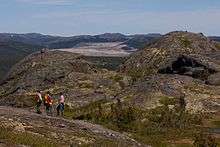Voisey's Bay Mine
Voisey's Bay Mine is a nickel mine in Labrador, Canada, near the bay of the same name.
 Open pit mine, Voisey's Bay | |
 Voisey's Bay Voisey's Bay | |
| Coordinates | 56°20′5″N 62°6′11″W |
|---|---|
| History | |
| Discovered | 1993 |
| Opened | 2005 |
| Owner | |
| Company | Vale Inco |
| Website | Vale.com |
Nickel deposit
A large nickel deposit was discovered in the hills along the western shore of Potato Island in September 1993 by Archean Inc.,[1] a prospecting firm hired by Diamond Fields Resources Inc. This deposit is considered to be one of the most substantial mineral discoveries in Canada in the last 40 years and is estimated to contain 141 million tonnes at 1.6% nickel.[2]
Surface mining began in Voisey's Bay in 2005 in order to access the nickel deposit.
Currently, the mining rights for the Voisey's Bay nickel deposit belong to the Toronto-headquartered Vale Inco company, a subsidiary of Vale. The bulk carrier ship Umiak I was built to transport ore from the mine.
Since the discovery of the Voisey's Bay deposit by Jean-Raymond Boulle and Richard Garnett of Diamond Fields Resources,[3] efforts have been increased to find similar deposits in coastal Labrador.
On 11 June 2018, Premier Dwight Ball announced Vale is moving forward with its underground mine at Voisey's Bay. Ball stated that the move will extend the mine's operating life by at least 15 years. Over the five-year construction, more than 16,000 person-years of employment will be created according to Ball.[4] First ore is expected no later than April 2021.
Labour issues
At present, workers at Voisey's Bay are flown in, via Voisey's Bay Aerodrome, from other communities in the province, and reside at a work camp while onsite. There are no current plans to build a permanent settlement at Voisey.
Workers at the site went on strike in the summer of 2006. A core issue in the dispute was pay equity with workers at Vale Inco's facilities in Greater Sudbury, Port Colborne and Thompson.[5]
The question of where Voisey ore would be processed had previously been one of the obstacles to developing the site, with the government of Newfoundland and Labrador demanding that a facility be built in the province to provide jobs there, while Inco workers in Sudbury and Thompson were simultaneously threatening to strike if the ore was not sent to their existing facilities in order to preserve and protect their jobs.[6] The existing workers in Sudbury and Thompson eventually accepted a compromise; the ore would be shipped to their facilities until 2011, then a new facility that was being built in Newfoundland would be ready to begin operations. The profits from Sudbury and Thompson would be reinvested in developing new mining sites in those communities. In November 2008 Minister of Natural Resources Kathy Dunderdale announced that construction should start in 2009 to build a $2B hydrometallurgical processing plant in Long Harbour on Newfoundland's south coast. Construction of the Long Harbour Nickel Processing Plant started in April 2009 and operations began in 2014.
References
- Raymond Goldie (2005). Inco Comes to Labrador. St. John's, Newfoundland, Canada: Flanker Press. p 365. ISBN 1-894463-75-7.
- "Important Facts: Project Overview- Voisey's Bay Project". Retrieved 9 May 2007.
- McNish, J. (1998). The Big Score. Doubleday Canada. p. 36. ISBN 978-0-385-25758-9. Retrieved 28 August 2018.
- "Voisey's Bay workers end strike after voting to accept deal", Canadian Broadcasting Corporation, 27 September 2006.
- "Cautious optimism", Northern Ontario Business, July 2002.